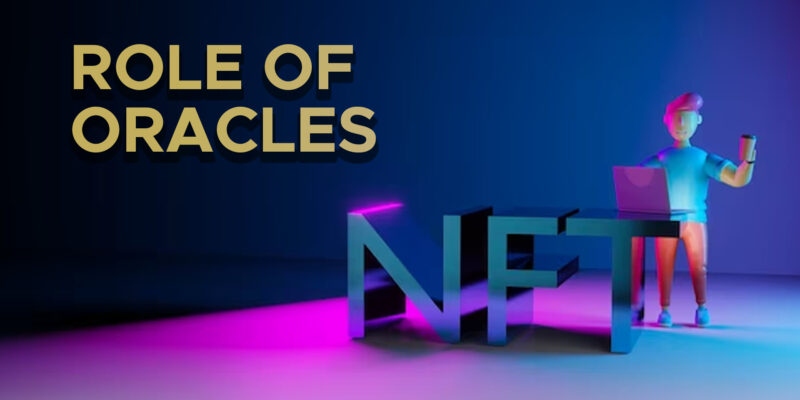- Oracles play a crucial role in the implementation and functionality of dynamic NFTs
- Creating dynamic NFTs involves incorporating interactive or changing elements
There are NFTs and there are dynamic NFTs. They’re erected by using smart contracts to incorporate real-time data handed by Oracles. This data can change grounded on external conditions, similar to rainfall conditions, the rearmost sports results, or price changes of underpinning means. One crucial element to know about dynamic NFT is the use of metadata. It describes the commemorative’s characteristics and can include different types of information, similar to names, descriptions, and features.
So when data is added to a dynamic NFT, it evolves and its metadata is streamlined. The data added can be both on-chain and off-chain data. On-chain refers to data similar to new high scores in a game. Off-chain data is imported via oracles and can be anything ranging from price differences of the real-world means to basketball scores.
Function Of Oracles In Dynamic NFTs
Oracles play a crucial role in the implementation and functionality of dynamic non-fungible tokens (NFTs). Oracles are collections of nodes or external services that provide and validate real-time, off-chain data to be used within smart contracts. In the context of dynamic NFTs, oracles enable the integration of external data sources and facilitate the updating and modification of the NFT’s metadata.
Oracles act as interposers between the blockchain and the real world. They fetch and transmit external data to the smart contract associated with the dynamic NFT. This external data can come from various sources. The Oracles ensure the authenticity and integrity of the data they provide, making it reliable and suitable to use within the NFT ecosystem.
When an oracle sends external data to a dynamic NFT smart contract, it triggers a change in the NFT’s metadata and appearance. The updated metadata reflects the new information and allows the NFT to adapt, evolve, or respond to dynamic conditions. For example, a dynamic NFT representing a weather-based artwork may have its metadata updated periodically with real-time weather data, reflecting the current conditions in the artwork
How To Create a Dynamic NFT
Creating dynamic NFTs involves incorporating interactive or changing elements into the non-fungible tokens. While traditional NFTs are static and represent fixed digital assets, dynamic NFTs can display various forms of interactivity, such as animations, videos, games, or data updates.
- Conceptualization and Definition of the Dynamic Element:
This section emphasizes the importance of conceptualizing the dynamic element that will be integrated into the NFT. It involves identifying the specific type of dynamic elements, such as animations, videos, games, or real-time data updates, that will bring interactivity and engagement to the NFT. Furthermore, it emphasizes aligning the dynamic element with the overall concept or narrative of the NFT to ensure coherence and a seamless user experience.
2. Planning the Design and Development:
The planning stage of creating dynamic NFTs is equally essential. Creating a comprehensive design plan that outlines the visual representation of the dynamic element within the NFT is a must. This plan serves as a blueprint for the development process. Additionally, it stresses the need to specify the technical requirements and specifications for implementing the dynamic element, considering factors such as file formats, duration, interactivity, and compatibility with blockchain platforms.
3. Developing the Dynamic Element:
This subheading delves into the development stage, where the dynamic element is brought to life. It mentions that those with programming skills can undertake the development process themselves, utilizing suitable programming languages such as JavaScript, HTML5, or Solidity. It emphasizes the importance of leveraging relevant frameworks to create interactive or changing functionalities within the NFT. Furthermore, it acknowledges that collaboration with developers, designers, or artists might be necessary for complex dynamic elements.
4. Deploying Your NFT:
In this section, the focus shifts to deploying the dynamic NFT on a suitable blockchain platform. It highlights Ethereum as a popular choice due to its robust smart contract capabilities, while also mentioning alternative platforms like Binance Smart Chain or Flow. The subheading says the need to write the smart contract code for the NFT, ensuring that it incorporates the necessary functionality to support the dynamic element. It also stresses the importance of deploying the NFT smart contract on the chosen blockchain platform and minting the NFTs by attaching the dynamic element to each NFT.
5. Marketplace Integration:
This subheading emphasizes the integration of dynamic NFTs into various NFT marketplaces to make them available for purchase. It suggests selecting reputable marketplaces that support the chosen blockchain platform. Furthermore, it highlights the need to provide comprehensive and compelling information about the dynamic elements present in the NFTs, showcasing their unique features and interactivity to attract potential buyers. The subheading also mentions the importance of setting a price or initiating an auction based on the marketplace’s guidelines, while also considering copyright and licensing regulations and seeking professional advice in legal and financial matters.
Conclusion
Creating dynamic NFTs offers an exciting avenue for artists, developers, and creators to push the boundaries of digital ownership and interactivity. By following the steps outlined in this essay, including conceptualizing the dynamic element, planning the design and development, implementing the dynamic element, deploying the NFT, and integrating with marketplaces, one can embark on the journey to create captivating and interactive digital assets that captivate and engage collectors in the ever-evolving NFT ecosystem.


Comments